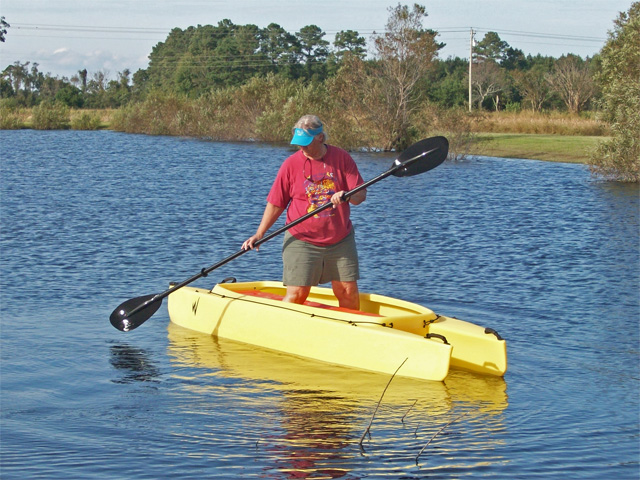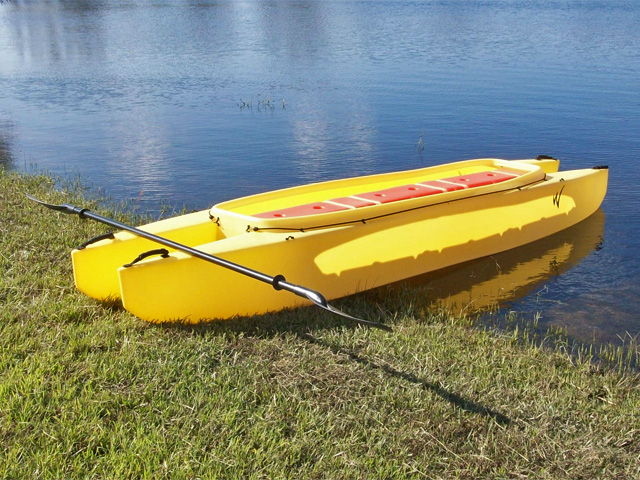By Jinsub Chung
New Hampshire
I really like everything in my Wavewalk 700 kayak for fishing and family time, and I use every opportunity that I have to take it out.
“My father is retired, and he owns a sixty thousand dollar bass boat that he takes out maybe twice a year, but he fishes out of his Wavewalk 500 nearly every day.”
-Clint Harlan, Missouri
Bass boats and flats boats have a lot in common, and they also differ from each other in some details.
Depending on their size and the speed required from them, these two families of small to medium size motorboats are propelled by one or more outboard gas engines, and they are relatively wide for their overall size.
The decks of both types of fishing boats are generally flat, and they don’t feature a cabin. Both types of boats feature a special casting area in the front of their deck, where one and sometimes two anglers can sit or stand, and cast comfortably.
Both bass boats and flats boats are stable, and their hulls are designed to have a shallow draft, which is why they are generally more flat than the deeper hulls of boats designed to travel offshore, in rough seas.
All these boats are comfortable to travel in and fish from, and the more expensive ones offer a plethora of amenities that make traveling and fishing easier, more comfortable, and more enjoyable for their crew.
Another noticeable difference between flats boats and bass boats is color – Flats boats tend to come in light colors, predominantly white, and bass boats tend to have a dark hull, with dark blue being their more popular color.
Many people who own a flats boat use it inland, in freshwater, as a bass boat, but it seems that the opposite is less commonly practiced.
Flats boats are skiffs designed primarily for saltwater, and in general, their makers strive to enable them to go in more ‘skinny’ water, namely very shallow water. They are named ‘flats boats’ after the wide stretches of flat, shallow water in coastal areas in the southern regions of the United States.
Fishing in shallow water is the raison d’être of flats boats, skiffs, etc. This is where fishers of all disciplines, from reel and fly fishing to net casting strive to get those big redfish, snook, seatrout, snapper, tarpon and many other species that live typically in those rich fisheries.
When push comes to shove, it’s the depth of the propeller that determines how shallow the water you can go in can be, and not just the number of inches that the hull drafts.
Unless a boat is outfitted with a special outboard motor called ‘mud motor’, the effective depth where you can drive it is about one foot of water, or more. This is because even a small propeller is about 8 inches in diameter, and it rotates at least an inch below the anti ventilation plate (often referred to as anti cavitation plate), which itself is required to be immersed in one to two inches of water below the hull’s lowest point (typically, its keel). And naturally, you need some good clearance between the propeller and the bottom of the body of water in which you’re navigating, or else…
Needless to say that the water you drive in has to be free of seaweed and other types of aquatic vegetation that’s likely to snag your propeller.
These are the reasons why you need an alternative mode of propulsion for the really ‘skinny’ water, and this alternative is poling –
The quintessential element that makes a boat a flats boat is the poling platform featuring at the stern, and some flats boats are dubbed ‘poling skiff’.
Opinions differ as to how effective poling is in terms of covering any meaningful distance, because in the first place, not too many people are sufficiently fit to pole, and even an athletic, experienced and highly motivated pole pusher cannot move a skiff at a speed that’s comparable to the speed achieved in kayaks and canoes.
As for poling against a current, even such as in a slow moving river, and let alone a faster, tidal current – good luck with that.
Being flat bottomed, flats boats don’t offer very good directional stability, and their high deck structures tend to catch wind, and for these reasons, plus the overall size and weight of the vessel, poling in unfavorable wind conditions must be ruled out.
To be fair, it would be hard for one person to move a fairly large and heavy boat such as a flats boat just by using their muscles. These boats don’t lend themselves to human powered propulsion, whether it’s paddling, rowing, or poling.
It seems like the only effective human powered mode of propulsion for boats this size could be stand-up sculling, which is a traditional method that’s still popular in Asia, especially with heavier boats. But stand-up sculling is a technique that requires a skilled and experienced rower, namely someone who’s in excellent shape and rows frequently, and let’s face it, this requirement doesn’t fit the description of our typical weekend flats fisherman…
The person who activates the push pole in a flats boat can help their fishing buddy by identifying fish from the height of their poling platform, but they are pretty much prevented from taking part in actual fishing action. Too bad for them…
Whenever you fish in skinny water that’s affected by tides, you risk getting stranded as the tide ebbs, and this means you and your fishing buddy would have to spend many more hours together, and in the company of mosquitoes. Lots of them… In other words, skinny water capabilities are not just about fishing.
Being full fledged boats, you can launch neither a bass boat nor a flats boat from a beach, let alone one where rocks and oyster beds are present, and you can’t launch from a dock either. You need a facility known as a boat ramp that allows you to access water that’s deep enough with the trailer on which you transport your boat. Such boat ramp has to have a parking lot too, for you and other boat owners like yourself to park your vehicles and trailers.
Driving to a boat ramp takes time, waiting for other boaters to launch and beach may take additional time, launching takes some extra time, and so does parking. And none of these activities is something to look forward to, because they’re not fun.
Taking your boat out is equally frustrating in terms of time wasted on doing other things that are not fishing.
Buying, operating and maintaining a bass boat or a flats boat isn’t cheap. However, we will not discuss these well known issues because we assume that if you’re reading this article, you can afford such expenses. Whether you would want to spend this money if you had a good, cheaper alternative to owning such a boat is another question. After all, owning a big and expensive boat offers other advantages that are not directly related to fishing.
In sum, neither bass boats nor flats boats are very practical for really shallow water and for shorter trips.
No sensible angler would consider a SOT or sit-in kayak (SIK) to be an alternative to a full fledged motorboat, because of the obvious shortcomings of fishing kayaks, which are that they are extremely uncomfortable, wet, and slow, and paddling or pedaling them takes too much time and energy. A kayak’s range of travel is limited, even with an electric trolling motor, and besides – why did we even bother to mention these kayaks in the first place?…
Canoes are OK for a crew of two paddlers (well, sort of), but they don’t work well for one paddler, and motorizing a canoe is problematic.
As for Jon boats, dinghies, and other smaller fishing boats, you need a trailer to transport them, and you can’t paddle them effectively.
Inflatables? Nah…
The patented twin-hull, 85 lbs W720 kayak skiff can be easily outfitted with an outboard gas engine, and easily driven across long distances. It’s back pain free, dry, and it offers plenty of storage. It paddles better than any other kayak out there, including in strong wind, and one person can car-top it effortlessly in less than thirty seconds.
You can launch a motorized W720 from any dock or beach, including rocky beaches, and you can paddle it in water that’s just a few inches deep, and even go over obstacles. The W720 is the most stable kayak out there (after the S4), and anyone can paddle it standing, and fish standing in it.
While the W720 is unrivaled in the world of kayaks, it is limited as far as load capacity is concerned. Its 400 lbs capacity is fine for two full size fisherman, an outboard motor, and plenty of fishing gear, but that’s about it – no carrying capacity for more, and this can be a problem for some people.
And this the perfect alternative is The S4 Microskiff.
This new boat does more than effectively bridging the worlds of kayak fishing and regular fishing from boats – It offers a range of benefits that in some cases make it a better solution than bass boats and flats boats –
The ultra lightweight (98 lbs) S4 can carry on board 600 lbs of passengers, motor and gear, which is enough for two large size fishermen, their fishing gear, and a powerful outboard. The 6 hp outboard featuring in our demo movies fits it perfectly.
The S4 offers all the advantages listed above for the W700, namely easy car-topping, easy launching anywhere you want, easy paddling, skinny water mobility, easy stand up fishing, comfort, storage, stand up paddling and fishing, etc., plus full tandem capabilities, for both short and long trips.
This makes the S4 both a full solo and a full tandem cartop boat and paddle craft, and if you tried to go on a fishing trip in a bass boat or a flats boat by yourself, without a fishing buddy, you’d probably agree that neither of these full-fledged boat types are optimal for one person to use on solo fishing trips. It can be done, but it’s not that much fun.
The S4 is a unique watercraft, and you’re likely to appreciate it either as a great alternative to a bass boat or a flats boat, or simply as a new type of fishing boat that redefines the market.
| Best Boat For Under $10,000 in 2024 |
Do you have any questions about this article?
Florida
Completely satisfied with my W700, nicknamed “Bonefish”
I put an electric 46# thrust electric motor on my W700, which gives me just under 4 knots speed. Perfect for the short distance backwater fishing I do. Went a total of 14 knots the other day (measured by iPhone app Navionics which can give you speed, route, and total distance of trip), This was an extra long trip for me through the narrow backwater channels. The W700 performed like a charm.
Designed some aids that makes the W700 easier to move around on dry land and load. One is a two wheel apparatus that allows me to easy take the kayak from my Jeep to my garage where I store the W700 (see attached photo). Could also be used if had a long distance from Jeep to water’s edge, but have not needed to use this as can drive the Jeep right up to the water.
Also designed a “Catyak” (Catamaran Kayak) roof rack that enables the W700 to sit on top on my Jeep without sliding side to side (photos attached). Only need simple ties for forward an back. Load the kayak from the front end of the Jeep, using the hood as a “stepping stone”. Lay down little throw rugs on the hood and top of Jeep which enables me to simply push the W700 up the “ramp” sitting squarely on the Jeep’s modified roof rack. Can load and unload the Kayak in couple minutes without much effort.
Made some aids for the battery holder, fish pole holders (see photo attached), and other minor items that enable me to easily maneuver around and fish out of the W700. Each trip I learn a little more and when come back, I make the adjustments required to simplify matters enabling more effortless time fishing. But that is the beauty of the W700, she enables you to personalize your Kayak to exactly how you want and your needs. You just have to be a little creative in coming up with aids that allow you to do this. There is NO manual…
Overall, having a great time customizing “Bonefish” and catching lots of Reds and Snook in the process.
Thanks…
Remo “Captain Bonefish”
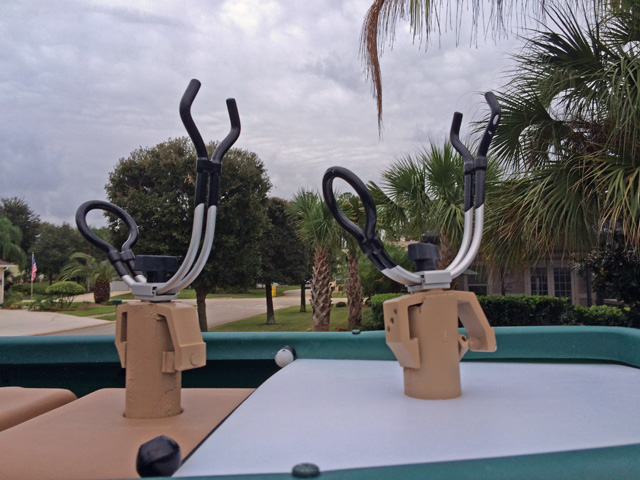
More rigging and fishing with “Captain Bonefish” »
More Wavewalk fishing kayak reviews »
North Carolina
It’s 7:53 am; where is Fishing Buddy?
Evidently, she is sitting in the driveway waiting for me to get it in gear so we can begin our day. Today; Saturday, October 24, 2015, is the first day of kayak fishing for me. I had hoped to go sooner, but when you own a business sometimes it just doesn’t work out.
The preparation for this day began last week when I knew I was lacking some stuff that other folks have on their kayaks. I installed an anchor trolley, some rod holders, and a couple of soft spots at either end of the saddle gunwales. I used pool noodle for the soft spots and Command brand strips for rod holders. I wasn’t sure about the rod holders, but they have worked out great. Simple, yet effective. Prior to installing the new stuff I totally snaked Steve Anderson’s paddle holder idea and made some of my very own. I used thin, flat aluminum bar and bent it to the contours of the kayak. I filed smooth the sharp edges and covered parts of the holders with good ‘ole duct tape. After all that work I felt way more prepared to use my kayak for catching.
I decided my first outing should be somewhere familiar and protected in case the wind blew a gale. Jan and I chose Lee Landing on the Upper Broad Creek of the Neuse River. The Neuse is brackish down my way, so we knew that we could potentially catch anything from sunfish to drum or speckled trout. Fishing Buddy gave me some advice about packing for the day and what to take and what not to take. I reorganized 3 times before I was satisfied with my choices and included flies and gear for typical salt and fresh water fishing. I also remembered the camera, yay for me!
We arrived at our destination, unloaded the kayaks from the vehicles and then loaded the kayaks with stuff. Fishing Buddy got on the water first and I followed eventually. I really need to work on the “scoot”. Alas, I was afloat and paddling toward a dock. My second encounter with a dock went a lot better than my first encounter. I slipped my fly rod from the holder and made a cast in anticipation of getting bent; I would have to wait a while before being bowed up. I paddled, cast, and repeated.
I hoped to catch some trout, so I started fishing with a black and orange clouser fly. I then changed to a chartreuse and white clouser fly after no strikes or hook ups. Fishing Buddy had changed from a tutti frutti fly to an all white with gold flash clouser fly and caught a bass on a sunny bank. I decided to go with a white wooly bugger, but that didn’t work too well either. We were both throwing intermediate lines and even though I usually throw a floating line when fishing small poppers, I decided I was going rogue. The wind was blowing me around pretty good, so I backed my kayak up into some reeds while I tied on that awesome little popper and when I was all tied up I eased over toward the sunny bank and made a cast between a cypress knee and a clump of reed grass. Float, strip, pause, strip, pause, BAM! FISH ON! I knew it was a bass because he commenced to pulling me toward his lair and I went to hollering. I was so happy that I evidently failed to see two folks paddling a canoe get close enough to join in the celebration. Unfortunately, my Fishing Buddy had paddled up the creek so she missed the whole scene. The nice canoe folks assured me that they would convey the good news when they got around the bend.
The remainder of the trip was spent catching pumpkinseeds and bass. I did manage to land a reed fish; they are very elusive you know.* 🙂 happy It was 2:00 pm when we arrived back at the boat ramp. We got loaded up and helped a fella get his boat trailer backed down the ramp to retrieve his boat, it was his first time and he needed a bit of guidance.
I had no idea that I had fished for 5 1/2 hours. I learned a lot today and will tweak some things for my next trip. I am so tickled with my kayak and I am so anxious to go again.
I have attached some pictures.
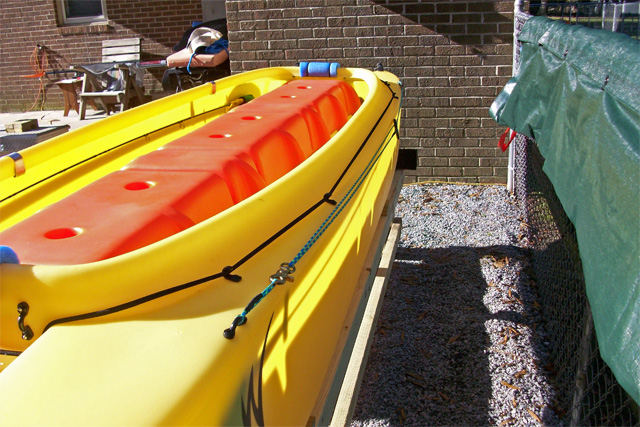
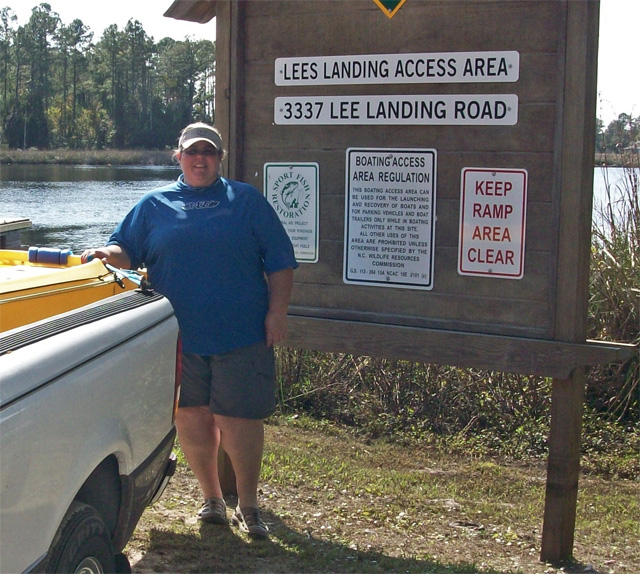
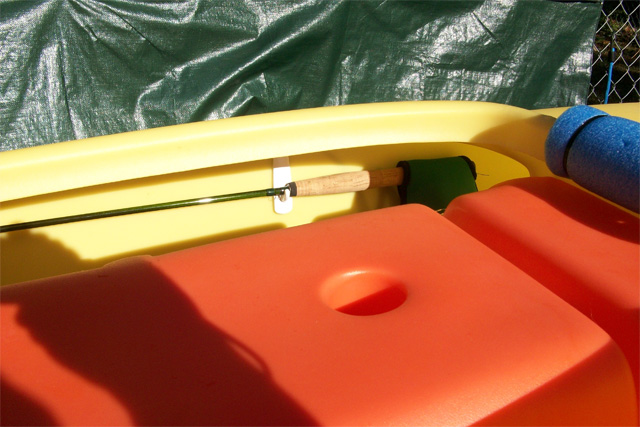
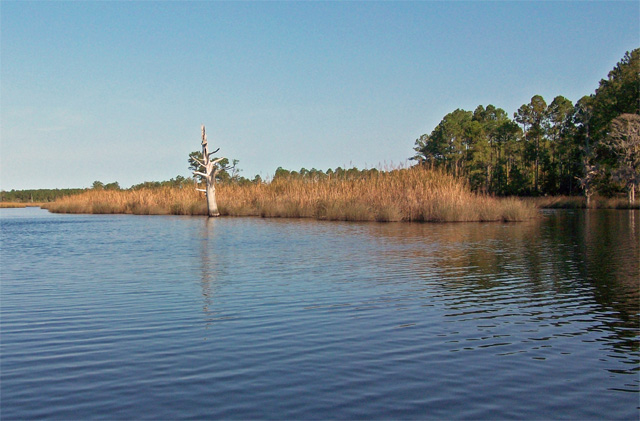
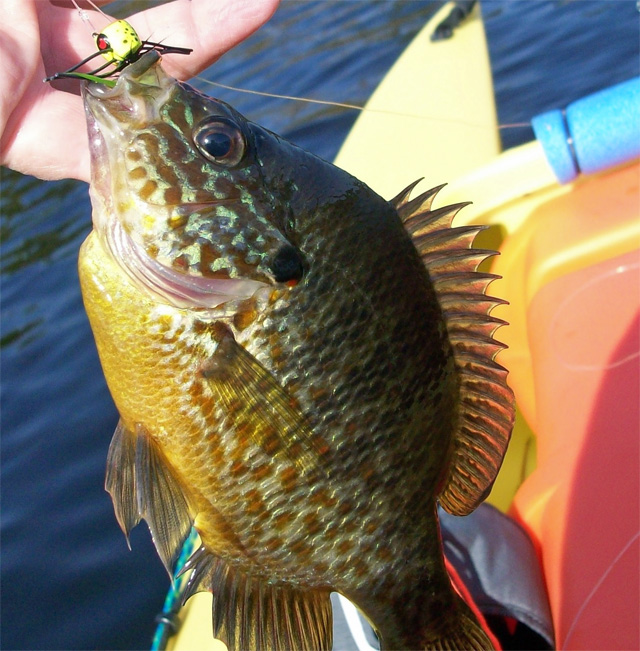
North Carolina
Today was the day; the maiden voyage of Float-n-Fly. There was more float than fly since it was my very first water day in my W700 and only my second time ever in a kayak.
The sun was shining, the wind was blowing about 10-15 mph, and the mosquitoes threatened to hijack my voyage by sucking all of my life blood from me. Despite the wind and squadron of eastern North Carolina skeeters; also known as crop dusters, I pushed off the bank and into a most epic experience. I was immediately blown into a scraggly bunch of above water branches and then decided I better do something so that I could actually claim that I paddled my kayak. I tentatively placed a blade in the water when my Fishing Buddy called out to me and said that my paddle was backward and upside down. Go figure; I did mention that this was my first trip, right.
Lesson #1-It does matter how you hold your paddle.
I adjusted the paddle and started with a good stroke, then another, and then another. Perhaps this was going to work after all. I paddled around in a circle; not because I tried to, but because the wind was pushing me around and around. I finally got turned toward the bank and glided right through the shallows and up onto the grass. It was at this time that I realized I was still on the seat of the kayak and not swimming to shore. Major accomplishment made super easy by the stability of the W700. Fishing Buddy, who is an avid kayaker, gave me some pointers on creating good, productive strokes by turning at my waist and when to lift the paddle out of the water.
Lesson #2-I am not paddling for a world record and it’s not a battleship. Easy and steady will get me where I want to go.
I received some more pointers and great information from Fishing Buddy about turning around and pushed off from the bank one more time. I paddled all around about half the pond practicing the proper stroke so as not to wear myself out and headed to the shore to find out how awesome, or not, I was doing paddling and turning. I said, “How do I look Fishing Buddy?”. She said, “Really good Fishing Buddy.” (“Fishing Buddy” is the nickname we use for each other because she; Jan, has a twin sister named Jill, and my name is Jill.) If you are confused, it’s okay because even after 8 years the guys in our fly fishing club can’t get our names right either.
Anyway, after she proclaimed that I was doing a good job I asked her what else I needed to know. She said, and I quote, “get the hell out so I can try it”.
I knew I had chosen a winner.
I want to talk about the obvious virtues of the W700 that are specific for me.
The first thing is that I am a bona fide big girl who loves to fish and wanted a new adventure. Most kayaks are not made for big girls and most big girls aren’t going to try kayaking or kayak fishing because you are afraid to be embarrassed by not being able to get in or out of a kayak. The W700 solves this problem with the ease of getting in and out without squatting, waddling, rolling, or flopping. You step in and sit down. It’s just that easy.
Secondly, I never felt like I was going to roll over, fall out or flip over. I was plenty nervous at first but I got my butt adjusted and just sat there. Easy, peasy. I wore my brand new life jacket in case I went for a non voluntary swim, so I felt very safe. Next time I will try standing up; which my Fishing Buddy was able to do right away. She is way more awesome than I, but I will get there.
Overall, I am just amazed with the W700 and so happy that I got one of my own. I have attached some pictures to prove it.
